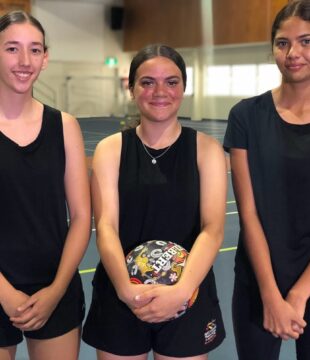The significance of all-Indigenous netball teams
By Sharon Finnan-White OAM
The concept of all-Indigenous sporting teams is nothing new with Cricket, Rugby League and AFL all fielding Indigenous teams over the years. The very first all-Indigenous cricket team toured England 145 years ago in 1868 and an Aboriginal rugby league side toured New Zealand in 1973. The first NRL Indigenous All Stars team was assembled in 2010 and all-indigenous AFL sides have been documented as early as the turn of the 20th Century.
Although these teams were here and thriving, all-Indigenous teams competing in netballs athlete pathway and competition framework was unheard of, that is, until now!
The involvement of our all-Indigenous team in the 2022 Townsville premier league competition (under our Indigenous Diamonds Pathway Program) will showcase the exciting skills and athleticism of our First Nations players and will bridge the gap between grass roots and elite level development for our players. This is a crucial gap that Netball Australia’s athlete pathway has been missing for too long.

For many years there has continued to be a culmination of inequities for Aboriginal and Torres Strait Islander netball players, umpires, coaches and administrators. Additionally, there have not been tangible outcomes or suitable pathways available for Indigenous females to receive culturally appropriate mentoring and coaching from elite-level role models, with only as little as two First Nations Diamonds in the history of the sport (Marcia Ella-Duncan and myself).
In the netball arena, all-Indigenous teams have been competing in First Nations carnivals for decades. Events such as the Koori Netball Tournament (which I established over 20 years ago at Charlestown Netball Association in NSW) as well as the Sharon Finnan Cup in Cairns, the NQ Indigenous Carnival in Townsville, State of Origin Series between NSW and QLD and a tri-series between NSW, QLD and NT were initiated. This was not only to provide participation opportunities for First Nations players and communities but also to scout talented athletes for further development as an alternative pathway.
For Indigenous programs and pathways to be sustainable they need to be recognised and supported by netball associations, state and territory member organisations (MO’s), and the governing body if they are to have a genuine and recognisable impact. It’s also important to note that there are First Nations community groups around the country, proudly coordinating and hosting their own Indigenous netball carnivals and have been doing this for numerous years. These events could be better supported by the MO’s not only for scouting out talented players but also to assist in building stronger relationships with these communities. This could very well be a fantastic contributor for development and partnership to grow and nurture our First Nations talented athletes. It is however pleasing to see that a few of the MO’s are either hosting annual NAIDOC carnivals and/or are creating programs for First Nations players and coaches within their respective states and territories.
Nonetheless, there is still much more work that can be done to ensure that there is a more strategic approach towards engaging with our First Nations communities, focusing on pathways and sustainability. I am hopeful that the Netball Australia First Nations Advisory Committee (FNAC) will receive the support and resources it requires to influence meaningful change in this space. The FNAC consists of Stacey Campton (Chair) Sharon Finnan-White OAM, Aunty Roma Pregarc, Josie Janz-Dawson and Marj Kerslake.
What does it mean for First Nations athletes to participate in all-Indigenous teams in netball’s competitions?
- They feel proud representing their family, culture and community.
- They get to build confidence to take on further opportunities in their netball journey.
- They can participate in a sport they love in a safe and welcoming environment.
- They get to receive holistic support from First Nations coaches and support staff who understand the barriers and challenges they and their families face.
- Playing alongside other First Nations athletes, creating feelings of support and pride.
- They can connect with cultural learnings and sharing of stories with teammates who all come from similar, yet diverse backgrounds.
And what will this mean for the First Nations communities overall?
- It provides inspiration and hope for up and coming First Nations players.
- It gives alternative pathways to participate in netball in a culturally safe environment.
- It works to create future female sport leaders to inspire the next generation.
- It spreads feelings of acceptance and welcomeness in the netball space.
- It creates visibility to role models for up and coming players and their peers to look up to.
- It shows them that the sport of netball supports culturally safe spaces.
What does all of this mean for the sport of Netball overall?
-
- We will be creating greater awareness of the barriers and challenges for First Nations players, coaches, umpires and administrators in netball.
- We will be developing more inclusive spaces in our games for these athletes to thrive and excel.
- We will be providing ways for our First Nations athletes to be identified for State and National selection.
- We will be opening doors for non-indigenous coaches to also work alongside First Nations athletes, coaches, umpires and administrators to develop and improve relationships with them and their families for years to come.

